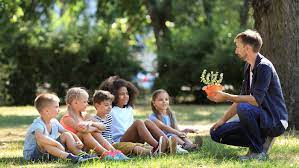Introduction
With climate change shaping the world’s future, teaching kids about this critical issue is more important than ever. But how do you explain global warming to a 5-year-old without causing fear? Or engage teens without overwhelming them? The key lies in using age-appropriate, hopeful, and empowering approaches.
Why It Matters
Climate change is no longer just a distant concern—it’s part of our daily lives. Teaching children about environmental issues helps them become responsible citizens who can take action. According to the United Nations Framework Convention on Climate Change (UNFCCC), youth engagement is one of the strongest tools in fighting climate change long-term.
Preschool & Early Elementary (Ages 3–7): Keep It Simple and Visual
At this stage, children are just beginning to understand the world around them. Focus on nature appreciation rather than the science of climate change.
- Use picture books like “The Earth Book” by Todd Parr.
- Introduce concepts like “reduce, reuse, recycle.”
- Plant a tree or garden together.
- Watch age-appropriate videos like Sesame Street’s Earth-friendly tips.
Late Elementary to Pre-Teens (Ages 8–12): Connect Cause and Effect
Kids at this age can understand basic cause-effect relationships. It’s the perfect time to introduce climate science and simple facts:
- Explain the greenhouse effect using a jar experiment.
- Discuss how pollution affects oceans and animals.
- Encourage participation in school-based green clubs or Earth Day activities.
- Watch documentaries like “Our Planet” together.
Teenagers (Ages 13–18): Encourage Critical Thinking and Empowerment
Teens can grasp complex issues and are often passionate about making a difference. Here’s how to engage them meaningfully:
- Introduce the concept of climate justice and activism.
- Debate pros and cons of renewable energy vs. fossil fuels.
- Encourage volunteering with local environmental NGOs.
- Let them follow young activists like Greta Thunberg for inspiration.
Tips for All Ages
- Keep the tone hopeful—avoid fear-based narratives.
- Use interactive learning: games, nature walks, and DIY projects.
- Practice what you preach at home: model recycling, composting, and energy-saving habits.
Digital Resources for Parents and Educators
Some excellent platforms to help you introduce climate change concepts at different developmental levels:
- NASA Climate Kids – Games and facts for younger children.
- Earth Day Toolkit – Project ideas and lesson plans.
- TED-Ed Climate Change Lessons – Animated videos and quizzes for teens.
Conclusion
By teaching kids about climate change early—and appropriately—we empower them to be part of the solution. From planting trees to understanding carbon footprints, every lesson builds a foundation of environmental stewardship. Remember: children don’t need to be overwhelmed with data; they need to feel they can make a difference.
Looking for fun ways to get started? Explore our eco-friendly projects and our carbon footprint explainer for children.


